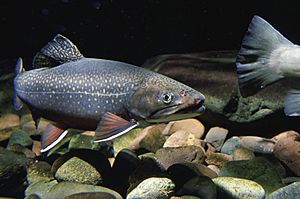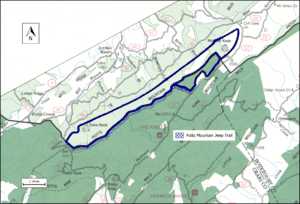Barbours Creek Wilderness Addition facts for kids
Quick facts for kids Barbours Creek Wilderness Addition |
|
|---|---|
| Location | Craig County Virginia, United States |
| Area | 844 acres (342 ha) |
| Administrator | U.S. Forest Service |
The Barbours Creek Wilderness Addition is a special wild area in western Virginia, United States. It's part of the George Washington and Jefferson National Forests. The Wilderness Society has called it a "Mountain Treasure." This means it's a very important place that should be protected. They want to keep it safe from logging and new roads.
This area is right next to the Barbours Creek Wilderness. It adds more wild space, especially for bears. It has a beautiful upland oak forest. You can also find a nice walking path along Potts Mountain. This wild area is also part of the larger Barbours Creek-Shawvers Run Cluster.
Contents
Exploring the Wilderness Addition
The Barbours Creek Wilderness Addition is in the Appalachian Mountains. It is located in Southwestern Virginia. This spot is about 18 miles southwest of Covington, Virginia. Barbours Creek runs along its south side. Roads like Va 617 and Va 621 are nearby.
Finding Your Way Around
There are no official trails in this area. But you can use an old, unpaved road called FDR 5036. It's also known as the Potts Creek Jeep Road. This road is about 1.1 miles long. It runs along the western edge of the area. You can park your car where Va 617 meets Potts Creek Road. This parking spot gives you access to the wilderness.
The map next to this text shows the boundaries of this wildland. The Wilderness Society decided these boundaries. The map includes two main areas. One is the Barbours Creek Wilderness Addition. It is on the southeast side. The other is the Toms Thumb wild area. This area is in the James River Ranger District. It is located on the west side.
You can explore the area using old logging roads. These roads were made long ago. They were used when trees were cut down in the early 1900s. Many of these old roads are now overgrown. But you can still walk on them.
Nature and Wildlife
This wilderness area is home to many plants and animals. It is part of a large forest region. This region is known for its broadleaf and coniferous trees.
Trees and Plants
You can find many types of trees here. These include yellow poplar, northern red oak, and white oak. There are also basswood, cucumber tree, and white ash. Eastern hemlock and red maple grow near streams. On the ridges, you'll see chestnut oak and scarlet oak. Yellow pine trees are also common on the higher slopes.
Water and Fish

Barbours Creek is a special stream. It is a "Class II" stream. This means it has good water quality. It is a natural home for wild trout. The Department of Game and Inland Fisheries classifies these streams. Class I is the best quality.
Old Trees
The area also has a small section of very old trees. Some of these trees are 140 years old or even older. They are called "old-growth" trees.
Mountains and Landscape
The land here has long ridges. These ridges run from northeast to southwest. They are made of sandstone or shale rock. Between the ridges are wide valleys. These valleys are made of limestone.
High and Low Points
Pine Mountain is a good example of these ridges. It has small, steep sides. The highest point in the area is on Pine Mountain. It is about 3,355 feet high. The lowest point is at Barbours Creek. It is about 2,260 feet high.
Most of the area sits on Silurian-aged sandstone. This type of rock is very old. Other parts of the area have different kinds of shale rock. These are called Brallier and Martinsburg shale.
How the Forest Service Manages the Area
The U.S. Forest Service takes care of this land. They study their lands to see which ones should be protected. They call these special places "wilderness." Wilderness areas have strong rules. These rules protect them from new buildings or roads.
Protecting Roadless Areas
The Forest Service found that Barbours Creek Wilderness Addition was a good candidate for wilderness protection. It was listed as an "inventoried roadless area." Later, a "Roadless Rule" was put in place. This rule stops new roads from being built in these areas. This helps protect the environment. It keeps these wild places natural. Because of this rule, Barbours Creek Wilderness Addition is safe. It is protected from new roads and timber sales.
Wildlife Habitat
The Forest Service also manages areas for recreation. They want visitors to know what they can do there. This area is managed as "Black Bear Habitat." This means it is an important home for black bears.



